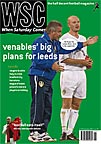 Paul Ashley-Jones is hopeful that the competition can become as big as that in Scotland – just without the elite few dominating it
Paul Ashley-Jones is hopeful that the competition can become as big as that in Scotland – just without the elite few dominating it
What were the aims of the LoW when it began? Have they been achieved?
The principal aim was to have a league that covered the whole of Wales and this was achieved. With the UK having long been criticised in international circles for having four represenative teams it was felt Wales needed a league to justify retaining the national side.
Are some fans still hostile to it?
Oh yes! Fans of clubs in the lower reaches of the English pyramid are paranoid that they will be coerced into joining. Not surprising really, as the FAW tried to do just that when the LoW was formed. Hopefully, the lesson has been learned that the League must make itself attractive enough to make these clubs want to join. There is even a LoW club (Rhyl) who want to return to the English pyramid, and last season Bangor City balloted their fans on whether they wanted to stay (most did). The League has its critics, due to poor results in Europe and lack of sponsorship, but it must be remembered it is only ten years old.
Is there any realistic hope of Swansea, Cardiff and Wrexham joining and do LoW clubs want them to?
Neither these clubs nor their fans wish to join, although there have been failed attempts (most recently by Cardiff’s Sam Hamman) to enter reserve teams as a back door entry into Europe. None of the “Big Three” have been able to compete in Europe since 1995, when UEFA decreed that only teams playing in their national league are eligible. The majority of LoW clubs do not expect or particularly want them as they would dominate the competition as Rangers and Celtic do in Scotland. But it is hoped that Colwyn Bay, Merthyr and Newport County will join.
How high are the standards?
Playing standards, along with facilities and crowds (currently averaging around 280) continue to improve. The League of Wales is at least comparable with the top level of the Dr Martens and Ryman. Fans also point to the increasing number of players moving to English professional clubs.
Milestones & Millstones
1992 The League of Wales (LoW) is formed with 19 teams kicking off on August 15. The first champions are Cwmbran Town (below).
1993 Cwmbran become the first LoW side to compete in Europe when they lose on the away goals rule to Cork City in the UEFA Cup. That sets something of a pattern.
1994 Striker Dave Taylor wins UEFA’s Golden Boot after scoring 43 goals for Porthmadog. The European governing body subsequently change the rules by introducing a weighting factor to try to prevent something similar ever happening again.
1996 Llansantffraid, a village team from mid-Wales, cause a major shock by beating champions Barry Town in the Welsh Cup final.
1997 In one of the least subtle sponsorship deals ever, Llansantffraid change their name to Total Network Solutions (TNS for short).
1998 Wales manager Bobby Gould calls up Barry Town defender Gary Lloyd into the national squad. Some claim it’s a publicity stunt.
2001 Barry Town become the first LoW club to get to the second qualifying round of Champions League.
2002 The Wales semi-professional side (made up mostly of LoW players) wins the inaugural home nations tournament, with victories over Scotland and Ireland and a draw against England. Hopes of securing a league sponsor for the first time in eight years are dashed as Honda pull out of a proposed deal due to a leak to a Sunday newspaper. First round defeats in Europe for Caersws (Intertoto) and Barry Town (Champions League) lead to renewed handwringing about the future of the league and calls for a move to summer football.
Fondly remembered
Mark Delaney ~ Former Carmarthen Town defender who is held up as an example of what players in the League can go on to achieve, Delaney left the LoW for Cardiff City before moving on to Aston Villa three seasons ago. Voted Villa’s player of the year for 2001-02.
Best forgotten
Alun Evans ~ As FAW secretary his dogmatic stance against those clubs who didn’t want to join the LoW created wounds that have still to heal (not to mention a hefty hole in the FAW bank balance for legal bills). Not quite forgotten, however, as he is still the LoW representative at the FAW.
From WSC 187 September 2002. What was happening this month